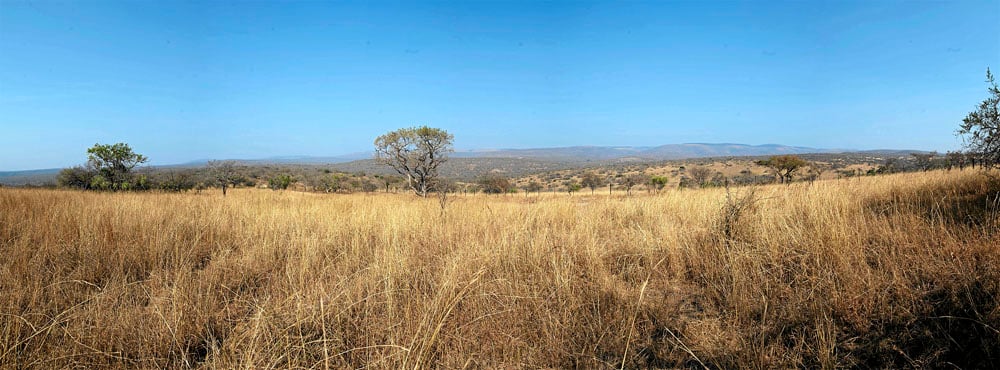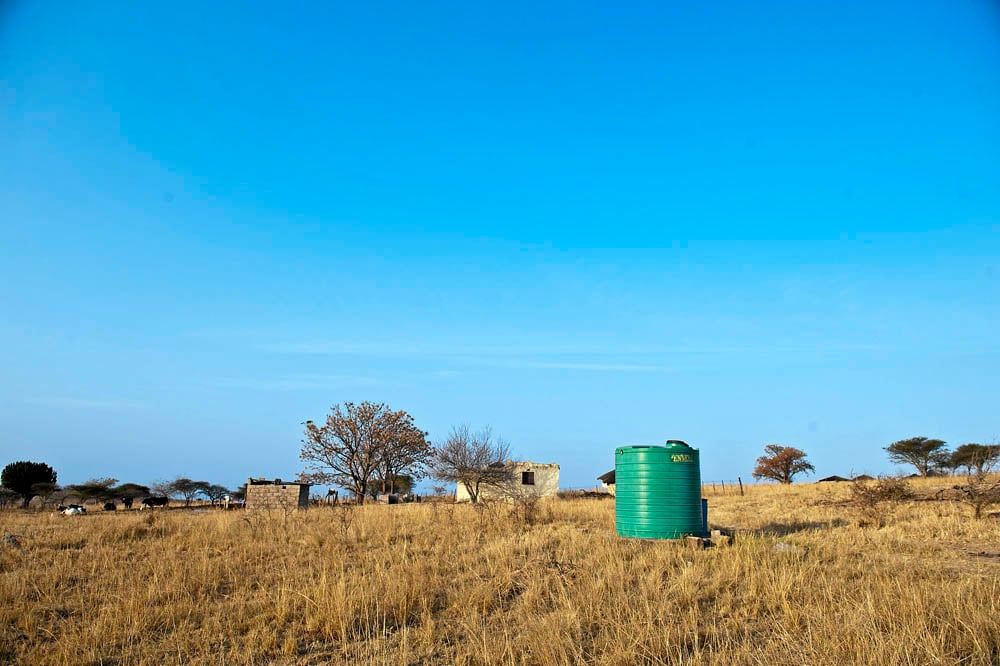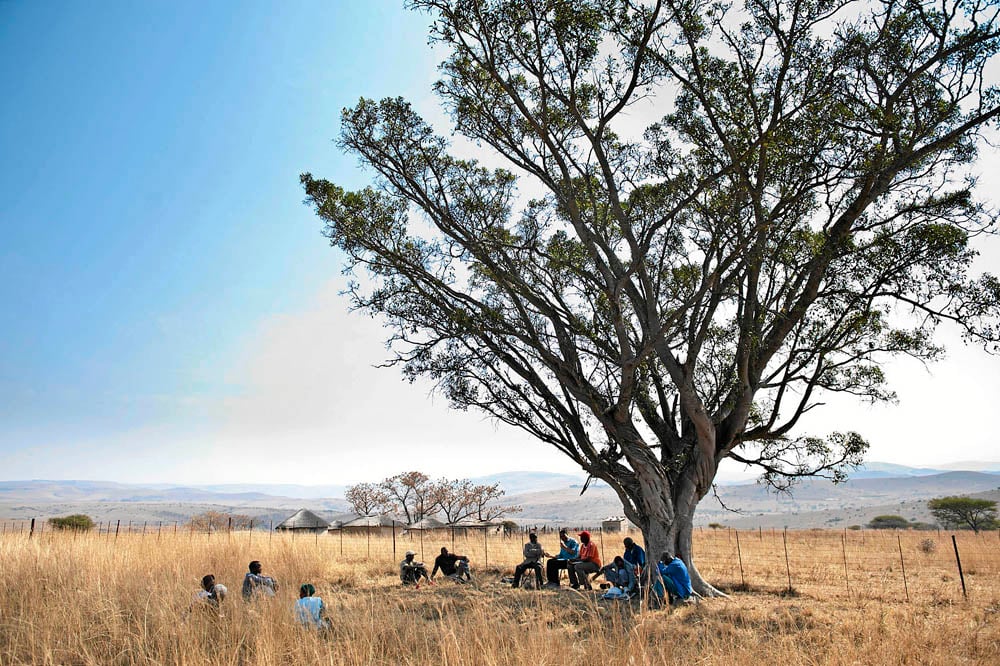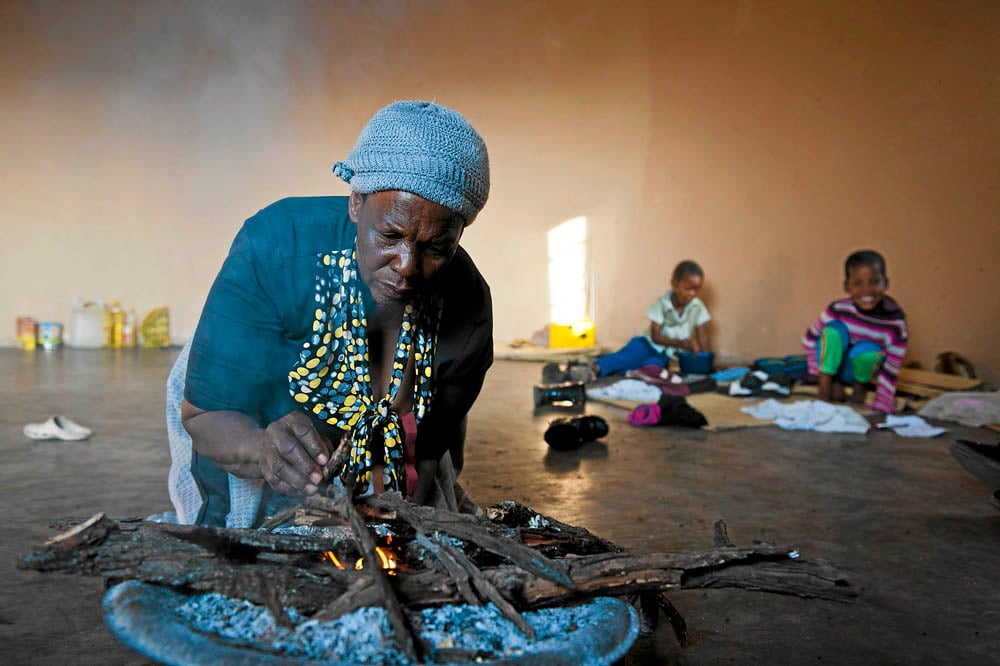Eighty-seven-year-old Bhekinkonzo Zulu speaks with a world-weary voice befitting an octogenarian. “I had eight cows when I lived here,” he says, sitting on a chair in a field surrounded by the thick bristles of brown ngongoni grass. “I had only two when I left. They got the diseases the other animals in the valley got.”
Dressed in an oversized grey coat, a tattered white shirt and a wide-brimmed leopard-print hat, Zulu has returned to the eMakhosini valley, near Ulundi in northern KwaZulu-Natal, to meet his former neighbours. He was evicted from eMakhosini years ago. A tributary of the White Umfolozi River runs through the valley. The soil is fertile and cattle thrive on the sweet grass. Seven Zulu kings are buried in the valley, and Shaka is said to have spent part of his youth there.
About 32 families that have lived in the valley for generations claimed land and labour tenant rights when the respective windows for application opened in the 1990s. Thirteen of the families have been evicted since the Amafa aKwaZulu-Natali heritage body began buying up land from Afrikaner farmers later in the decade. The claims, in total, affect more than 400 people.
Established in 1997 under the KwaZulu-Natal Heritage Act, Amafa almost immediately began acquiring land from the farmers, whose forebears had portioned it up after their involvement in the defence of Dinuzulu kaCetshwayo against Zibhebhu in 1884. They were awarded land after the battle.
The families facing eviction say the removals are to make way for Amafa’s grand plans: a tourism destination that could become “one of the foremost in Africa”, according to a speech made by Inkatha Freedom Party president Mangosuthu Buthelezi at the launch of the eMakhosini project in 1998. He went on to say that “the cradle of the Zulu people lies in this very valley”.
The project includes a game farm, a museum, a “heritage park” and a lodge. The park – called eMakhosini-Ophathe – was opened in 2003 by King Goodwill Zwelithini kaBhekuzulu, and has been stocked with buck, wildebeest and giraffe.
‘I can’t plant anything’
Zulu sighs and reels off a long list – beans, potatoes, sweet potatoes, sorghum and corn – that he grew while living in eMakhosini. “If you visited me, I would go to my garden and pick out some things to make sure you didn’t leave empty-handed. I now rent a room in the township [in Babanango] and I can’t plant anything because that is all municipal land.”
He says his family comes from a line of farm labourers, but the farmers, unlike Amafa, did not restrict them in how much they grew or the number of livestock they kept.

Babanango residents are directly threatened by plans to erect yet another palace for the King on their ancestral land. (Photos: Delwyn Verasamy, M&G)
Close to the R66 highway, on high ground with panoramic views of the valley, is where locals say the king will build his eighth palace.
Down in the valley you can see the partially restored domed huts of uMgungundlovu, which was once the seat of King Dingane.
There is a lot riding on the valley’s fortunes. Amafa says it now owns about 12 farms around eMakhosini, totalling 14 636 hectares, collectively bought for close to R8.2?million between 1997 and 2003.
Self-sufficient
Bheki Khanyile, who grew up working for a farmer, as his parents had done, says: “We hardly got paid [as farmworkers], but my grandfather would down a bull every July to celebrate his harvest. I didn’t even know that you bought mealie meal in a shop until the Eighties, when the white man I was working for quit farming.”
Khanyile’s neighbour, the rotund, stately Msizeni Magwaza, says from his lounge in eMakhosini: “My great-grandfather fought in [the battle of] Isandlwana in 1879. He departed for the battle from here. My grandfather knew [King] Dinuzulu in the flesh. He was there at his funeral. I heard from my grandfather that the whites didn’t want his coffin to be opened. I didn’t read it in the papers.”
Magwaza keeps all the documents related to the community’s ongoing battle with Amafa.
He says that, at a restitution hearing in Ulundi in 2013, the king’s spokesperson, Mbonisi Zulu, told him and others that they had no tenure rights over eMakhosini and should leave the area because royal graves are located there. Zulu would not comment on this claim.
Magwaza says the number of graves inside the reserve has been exaggerated, with the final resting places of kings Senzangakhona, Jama and Dinuzulu all falling outside the reserve where the claimants live.
No claims
Werner Els, a farmer who owned the farm Heelgoed in the vicinity and sold it to Amafa aKwaZulu-Natali in 1997, says that when he sold the farm there were neither restitution nor tenure security claims on it.
On other farms, such as Vaalbank, dwellers were given nontransferable, single-generation tenure rights under the guise of title deeds.
There are two categories of claims on farms currently owned by Amafa: those for restitution and those for land tenure.

Wild animals have been introduced and a new fence has cut residents off from their water supply.
Mbuyiseni Magwaza and Funo–kwakhe Gumede, representing their respective families, lodged restitution claims for Heelgoed in 1998. The Magwaza family claim is now being spearheaded by Msizeni in the wake of his older brother Mbuyiseni’s death. According to the younger Magwaza, the claim is still “in its research stages. Every six months I get a document saying it’s being researched. I’m not sure how long research can take.”
Ozias Mashele Buthelezi, a former farmworker in the valley, lodged a restitution claim for portions of two farms – Melkboom and Pandasgraf – in 1995. He has heard nothing further. The farm has since been sold to Amafa aKwaZulu-Natali. On another portion of Pandasgraf, Bakhipheni Ntanzi lodged a restitution claim on behalf of eight families. None of these has gone beyond the research stage.
The majority of the claims, affecting over 300 people, are land tenure claims on seven farms owned by Amafa: Slabatini, Evergreen, Moordplaats, Wegekozen, Wyde–gelegen, Heelgoed and Uitzoek. According to the regional land claims commission, none of these claims has been processed.
Unresolved claims
The commission’s Nokuthokoza Ndlela confirmed that the restitution claims remain unresolved, but would not elaborate. An official speaking on condition of anonymity said there are several reasons why research could take more than a decade, such as a lack of title deeds, the mapping of the area being claimed and the need to go through archival material.
On the labour tenant claims, Sipho Dlamini, a spokesperson for the department of rural development and land reform in KwaZulu-Natal, says that labour tenants’ applications have been received. “[The] landowners [Amafa] were informed by following the due processes and there were no denials nor confirmations of labour tenants’ status. However, the land owners proposed, for the sake of progress, a model that will settle both the restitution and labour tenant claims as a consolidated land offer.”

Disaffected eMakhosini residents meet to discuss their grievances.
Speaking on behalf of the claimants, Thokozani Ndawo says they had never heard about this consolidated proposal. “We have fought for all parties to be present [Amafa, the regional land claims commission and the farm owners],” says Ndawo, who lives in Heelgoed.
“The issue of Vaalbank, which was a farm offered to all of us by Amafa, was raised unilaterally by them, with neither the input nor the mediation of the land reform department.”
Collectively, the residents speak of brutal evictions. They complain that their livestock are contracting bovine catarrh disease from the wildebeest introduced to the game reserves and that their grazing and water sources have been fenced off.
Compensation
Lindi Msomi, the acting chief executive of Amafa, says that residents were compensated with the sum of R20 000 in the late 1990s but that the current rate is R50 000. This was to cover their relocation and rebuilding costs.
She says Amafa has never insisted that the families vacate the property. The heritage agency had purchased a farm called Vaalbank – to the west of the valley – which it said had good water and grazing, with a view to offering this land with full title to the families and constructing equivalent homes to those being vacated. The offer was turned down.
Minah Buthelezi, a pensioner, says in 2004 she was offered R20 000 to relocate to Vaalbank, but it was not enough as she had also lost livestock to disease. Buthelezi says Vaalbank is full of cliffs and rocky terrain, and is an arid outcrop compared with eMakhosini.
Amafa’s Msomi says labour tenant families were first approached individually and informed about the nature of the eMakhosini valley project, and were offered compensation to relocate or the option of staying under labour tenant conditions. “All people who have been relocated have done so either at their own request or have accepted the offer of compensation and assistance with the moving of personal effects,” she says.
On the issue of forced evictions, she says: “Many of the homes were demolished in the process of moving, as the owners who were moving themselves removed much of the building material. Once vacated, the remaining ruins were demolished.”
Government error
Thabiso Mbhense, a lawyer working for the Legal Resources Centre (LRC), says: “Unfortunately, the restitution land claims were ignored by the regional land claims commissioner in KwaZulu-Natal and were not published in the Government Gazette.
“On the other side, their claims under the Land Reform (Labour Tenants) Act (3 of 1996), the director general was supposed to refer their matter to court a long time ago, because the owners of the land [Amafa] actually disputed that they are labour tenants. There is no doubt that the department of rural development and land reform did not perform their function in these cases.”
Mbhense from the LRC said the organisation will continue to follow up the claims on the farms owned by Amafa. A recent joint statement released by the Rural Women’s Movement, the Association for Rural Advancement and the University of Cape Town’s Centre for Law and Society said: “There are about 20 000 claimant groups across the country who share their dilemma of an unresolved restitution claim more than 15 years after the initial lodgement period closed. Claimants’ fears of their outstanding claims being trumped by new ones are aggravated by the fact that the land claims commission is doing a poor job of communicating with them.”

Sibongile Mthimkhulu faces the threat of being evicted.
Although Amafa aKwaZulu-Natali states that none of the land in eMakhosini belongs to the Ingonyama Trust (a trust established during apartheid’s nadir, entrusting the Zulu king with close to three million hectares in the province), the KwaZulu-Natal Wildlife website suggests the heritage park is a collaboration, with portions of the land owned by Ingonyama Trust.
“Representatives of his majesty approached Amafa, requesting that a portion of land be allocated for the construction of a royal homestead,” said Msomi of the king’s planned new palace. “The council of Amafa saw the value of the presence of the king of the Zulu in a project that focused on the roots of the Zulu nation and approved, subject to environmental and heritage legislation, that a portion of land of around 10 to 20 hectares could be leased to the royal household for this purpose.” She would not disclose the lease amount.
No royal comment
Mbonisi Zulu, the king’s spokesperson, said the king will not comment on anything to do with land or land claims because legal processes were being followed. He referred queries on the king’s lease to Amafa.
Judge Jerome Ngwenya, the chairperson of the Ingonyama Trust Board, said he is not aware of a lease between the Zulu king and Amafa.
According to a department of rural development and land reform report, there are more than 3 346 unresearched restitution claims, of which 1 359 are in KwaZulu-Natal. Most of the land claim disputes are also in the province.
On the land tenure side, 18 000 farm dwellers in the province this week took the department to court over unprocessed land claims.